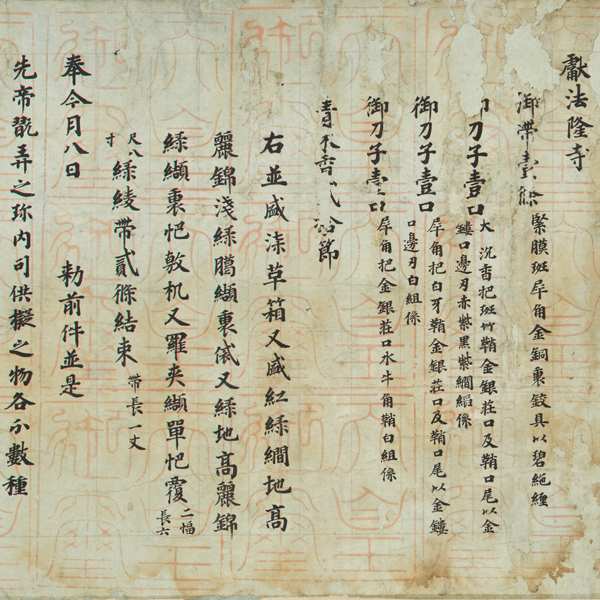書跡―法隆寺献物帳と古今目録抄―
染織-さまざまな技法の染織品-
染織-さまざまな技法の染織品-
-

国宝 法隆寺献物帳(部分) 奈良時代・天平勝宝8年(756)
法隆寺宝物館 第6室
2024年4月9日(火) ~ 2024年5月6日(月・休)書跡は「法隆寺献物帳」と「古今目録抄」を紹介します。染織は、繡仏裂をはじめ飛鳥から奈良時代の錦や広東と呼ばれる経絣、綴織、絞り染めの纐纈、描絵などを展示し、幅広い技法を紹介します。
書跡
| 指定 | 名称 | 員数 | 作者・出土・伝来 | 時代・年代世紀 | 所蔵者・寄贈者・列品番号 | 備考 | |
| おすすめ | 国宝 | 法隆寺献物帳 | 1巻 | 奈良時代・天平勝宝8年(756) | N-5 | ||
| 重文 | 古今目録抄(聖徳太子伝私記)上巻 | 1帖 | 顕真筆 | 鎌倉時代・13世紀 | N-18-1 | ||
| 古今目録抄写(別本) | 1巻 | 南北朝~室町時代・14~15世紀 | N-19 |
染織
| 指定 | 名称 | 員数 | 作者・出土・伝来 | 時代・年代世紀 | 所蔵者・寄贈者・列品番号 | 備考 | |
| おすすめ | 重文 | 繡仏裂 | 1枚 | 飛鳥時代・7世紀 | N-32-2 | ||
| おすすめ | 重文 | 繡仏裂 | 1枚 | 飛鳥時代・7世紀 | N-32-5 | ||
| おすすめ | 重文 | 繡仏裂 | 1枚 | 飛鳥時代・7世紀 | N-32-1 | ||
| 連珠円文刺繡 | 一括 | 飛鳥時代・7世紀 | I-336-106 | ||||
| 赤地花入連珠円文錦天蓋垂飾 | 1枚 | 飛鳥~奈良時代・7~8世紀 | I-336-64 | ||||
| 赤地鹿文描絵綾天蓋垂飾 | 1枚 | 飛鳥時代・7世紀 | I-336-1 | ||||
| 青緑地綾・紫地綾縫い合わせ | 2枚 | 飛鳥~奈良時代・7~8世紀 | I-336-22 | ||||
| 紫地双竜二重連珠円文綾 | 1枚 | 飛鳥~奈良時代・7~8世紀 | I-336-35 | ||||
| おすすめ | 黄地葱花山形文綴錦残欠 | 1枚 | 飛鳥時代・7世紀 | N-312 | |||
| 縹地連珠襷花文錦 | 1枚 | 飛鳥時代・7世紀 | I-336-54 | ||||
| 縹地連珠襷花文錦 | 1枚 | 飛鳥時代・7世紀 | I-336-55 | ||||
| 茶地獅噛動物文錦裂 | 一括 | 飛鳥~奈良時代・7~8世紀 | N-46-2-2 | ||||
| 茶紫地広東裂 | 4枚 | 飛鳥~奈良時代・7~8世紀 | I-336-91-1 | ||||
| 赤茶地花獅子連珠文錦 | 1枚 | 飛鳥~奈良時代・7~8世紀 | I-336-74 | ||||
| 赤地亀甲繋花葉文錦 | 1枚 | 飛鳥時代・7世紀 | I-336-51 | ||||
| 赤地花形目結文纐纈平絹幡足 | 1条 | 奈良時代・8世紀 | I-336-10 | ||||
| 紺地目結文纐纈綾 | 1枚 | 奈良時代・8世紀 | I-336-15 | ||||
| 淡黄緑地目結文纐纈綾 | 1枚 | 奈良時代・8世紀 | I-336-17 |
